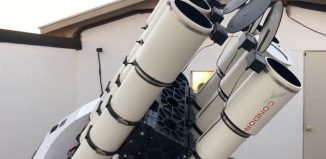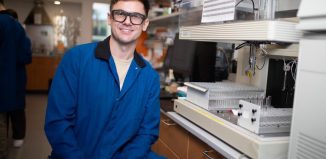Huilin Li’s discovery a ‘game changer’ in DNA world
Life depends on taking a set of instructions and copying them over and over. That’s how the code that builds everything from aardvarks to kangaroos to zebras works. Inside each cell, a set of blueprints provides a twisting, ladder-like key that enables plants, animals and yeast to survive, grow and produce the next generation.
While the way that code is copied in creatures like bacteria is well known, the key structural changes that lead from the beginning of the copying process to a full-fledged new set of instructions for so-called eukaryotic organisms, or those with a true nucleus, remains a mystery for organisms like fruit flies, elephants, kangaroos and humans.
“In eukaryotes, the machine performs a similar function” as it does for bacteria, said Huilin Li, a biophysicist at Brookhaven National Laboratory and a professor of biochemistry and cell biology at Stony Brook, “but it’s more complicated. When it’s larger, it’s difficult to deal with and it’s difficult to study its structure.”
The concept of replication, or copying, is known. Li is studying the steps to get from the beginning of a copy to another model with the same important genetic information embedded in it. “Life has evolved this powerful copy machine and we want to know how the copy machine is assembled from scratch and how it works,” said Li.
Li likens his work to studying a car. “If you never saw a car and you suddenly see it running, you would wonder how it can move,” he said. Many of the protein complexes he studies can literally be called nanomachines, he said. Seeing the structure will help determine the function, he said. Quoting Albert Einstein, Li said, “If I can’t picture it, I can’t understand it.”
Li uses an electron microscope to magnify these parts up to a few million times. When he takes a picture, he explained, he controls the number of electrons to keep what he is looking at intact. Because he can’t use that many electrons, however, the picture is not fully exposed, leaving the image blurry or noisy. He takes many of these pictures and uses a computer to average them to get a sharper image.
Li’s work with electron microscopy has “definitely made a splash,” said Christian Speck, a nonclinical lecturer in the Faculty of Medicine at the Institute of Clinical Science at the Imperial College in London, who has collaborated with Li for over a decade. “I still remember when we saw the first structure of a large replication complex in 2004, we all realized that [Li’s] approach was a game changer. We had to think about DNA replication from a completely different perspective, as we could see for the first time the proteins that we have been working on for such a long time.”
Over the years, Li has determined the structure of a genetic machine called the Origin Recognition Complex. The ORC, which is comprised of six proteins, finds the special stretches of DNA, called replication origins, in the sea of a genome. Like a car that consumes gas, the ORC burns a form of chemical energy called adenosine triphosphate.
The ORC recruits a secondary machine, called a helicase, that splits up the DNA. “We recently captured a picture of the recruitment process,” said Li.
Working with Speck, who was at Cold Spring Harbor Laboratory when he started collaborating with Li, the tandem figured out the structure of this 14-protein, two-machine system. When these machines aren’t closely regulated, they can overduplicate DNA, leading to uncontrolled cell growth and proliferation. “A hallmark of cancer is the regulation of replication,” Li said. “They don’t stop replicating” when normal cells would.
Li is also trying to understand how a protein machine called proteasome helps the tuberculosis-causing bacterium, Mycobacterium tuberculosis, survive inside the host immune system.
Li and his wife, Hong Wang, who works in the microbiology and immunology department at Stony Brook, live in Miller Place. They have two sons, Paul, who finished his first year at the University of Miami and Calvin, who just completed his junior year at Miller Place High School.
Li grew up in China and came to the United States in 1994. He enjoys walking in the Pine Barrens at the Rocky Point Preserve.
In his approach to his work, he has a “deep appreciation of what’s under the surface,” he said. “As a scientist, part of the job is learning and, for that, it is really a privilege.”






